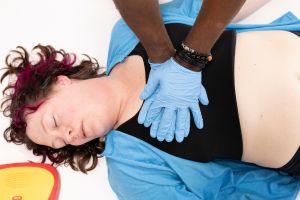CPR in Real Life vs. Movies
In movies, CPR is often performed with just a few chest compressions followed by a quick, miraculous recovery. Unfortunately, real-life CPR is far more intense, and outcomes can be different. CPR is done when someone's heart has stopped beating. Performing strong and continuous chest compressions helps circulate blood until professional help arrives.Bystander CPR, where a nearby person steps in to perform CPR, is critical in those first moments and can make a huge difference in the outcome. To be more specific, effective bystander CPR, when administered immediately following a cardiac arrest and combined with an AED, can double or even triple a person’s chance of survival.
But what are the real-life situations where you need to act? Let's look at when you should and should not perform CPR.
When Should You Perform CPR?
Knowing when to administer CPR can be the difference between life and death. Here are some situations where performing CPR is absolutely necessary:- Unresponsive and not breathing: If someone is not breathing or only gasping, CPR should be initiated immediately.
- Cardiac arrest: If the heart has stopped beating, which is confirmed when the person is unresponsive, CPR must be performed.
- Drowning incidents: In cases of drowning, performing CPR as quickly as possible increases the chances of survival.
5 Situations When You Do Not Perform CPR
As important as it is to know when to give CPR, it's equally crucial to know when NOT to perform it. Here are five scenarios where CPR might not be necessary:- If the person is breathing normally: If there are signs of normal breathing and a pulse, there is no need for CPR.
- If someone has a "Do Not Resuscitate" (DNR) order, it means they have made it clear they do not want to be resuscitated. Honouring their wishes is important.
- Obvious signs of death: When someone has clear signs of death, such as rigour mortis, CPR will not help.
- Massive trauma or catastrophic injuries: In some cases, like when someone has extraordinarily severe injuries, CPR might not work.
- If it is not safe to do so: Always ensure your safety before starting CPR. If a situation is too dangerous, wait for professional help.

Learning CPR Can Empower Anyone to Be a Lifesaver
The reality is, in emergency situations, knowing when to administer CPR or how to perform it correctly can save lives. This is where a first aid course comes in. Not only will you learn the steps of real-life CPR, but you will also be equipped with the skills to stay calm and handle a range of emergencies. Through proper training, you will be able to confidently answer questions like "When to give CPR?" and recognize the signs so that CPR is performed when necessary.In these lessons, you will learn how to use an AED (Automated External Defibrillator). A crucial tool for emergencies, it can help restore someone's heart to a normal rhythm. Bystander CPR, even with basic CPR skills, can make a significant difference and help someone survive if they have a heart attack.
Real-Life CPR: A Tough but Vital Skill
Unlike what is portrayed on screen, CPR is physically demanding. Each chest compression must be hard and fast, at a rate of 100-120 compressions per minute. And it is exhausting, especially when it is done for several minutes until professional help arrives. But it is worth it. Every minute without CPR leads to a decrease in survival rates.CPR training does not just teach you the physical steps—it gives you the confidence to act in an emergency. And trust us, when you are in the moment, those lessons are priceless. Every second matters, and by stepping in to provide bystander CPR, you could save someone's life.
The Red Cross is Here to Help
At the Canadian Red Cross, we offer high-quality CPR and first aid training. The classes are taught by certified experts. It does not matter if you don’t know anything about first aid or if you just want to brush up on your knowledge; our classes cover everything you need to know. You will learn when to perform CPR and how to do it well.Real-life CPR is not glamorous or quick like it is in the movies, but it is one of the most important skills you can learn. So, if you are ready to be prepared for an emergency, sign up for a CPR course today. Your actions could be the difference between life and death for someone in need.

